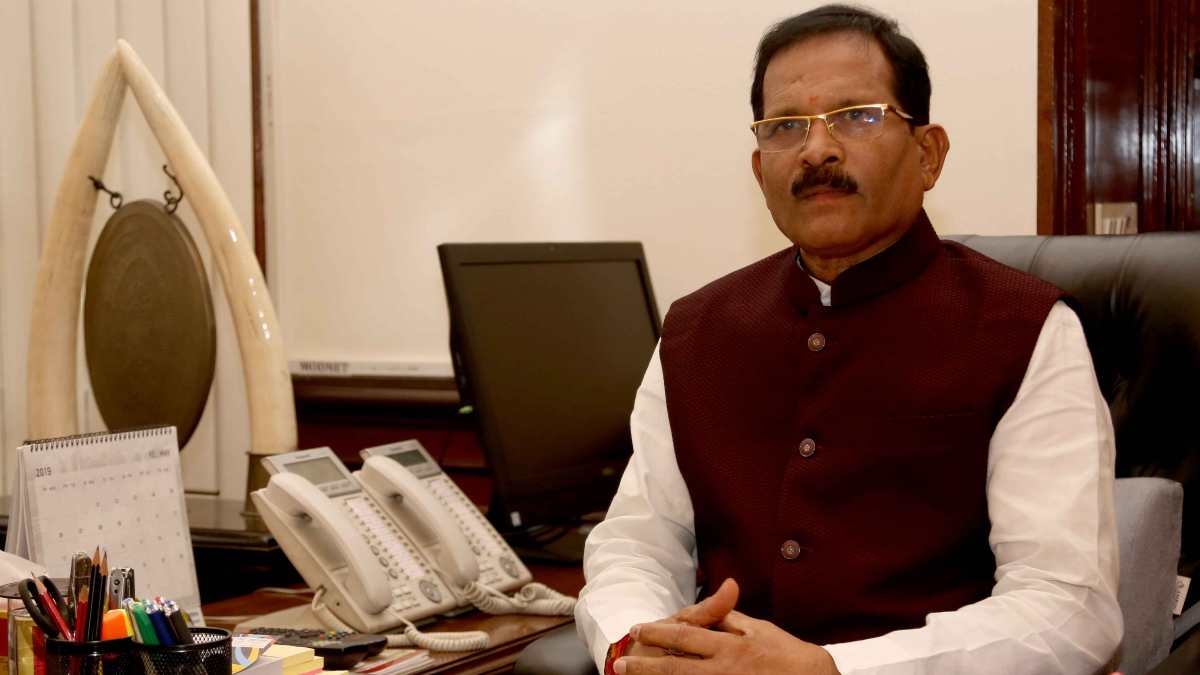Minister of State for Defence Shripad Naik in written replies to various questions in Rajya Sabha on Monday shared the details ranging from ceasefire violations by Pakistan, India’s retaliation, ‘Make in India’ and ‘Atmanirbhar Bharat’ initiatives in defence sector, to various aspects of FDI in defence. The minister came out with a detailed response on all the issues pertaining to the defence sector.
MoS for Defence Naik informed that Indian armed forces have recorded as many as 3,186 instances of ceasefire violations along the Line of Control (LoC) in Jammu region between January 1 and September 7, 2020.
According to the data submitted with the reply, 242 incidents of cross-border firing have occurred along Indo-Pak International Border in Jammu region between January 1 and August 31 of this year. The minister also replied that the Indian Army suffered eight fatal casualties and two non-fatal casualties in all of these instances recorded till September 7.
In addition, there have been five non-fatal casualties of Border Security Force (BSF) personnel along the LoC in Jammu and Kashmir. “Appropriate retaliation to ceasefire violations, as required, was carried out by the Indian Army and the BSF,” said the minister. Indian authorities also took up all cases of ceasefire violations with Pakistan authorities through the established mechanisms of hotlines, flag meetings, Directorate General of Military Operations talks as well as diplomatic channels between the two countries.
The most recent instance of ceasefire violation was reported from J&K’s Rajouri district on September 7. A statement by the Ministry of Defence had stated that this firing from small arms and shelling from mortars from across the border was “unprovoked”.
Earlier this month, recently appointed Director-General (DG) of the BSF, Rakesh Asthana had told jawans at the force’s Paloura camp, “Our role has become more important now as we are the first line of Indian defence.”
FUNDS FOR DEFENCE MODERNISATION
MoS Defence Shripad Naik in a written reply to P Bhattacharya and Vijay Pal Singh Tomar in Rajya Sabha on Monday gave details about the defence modernization efforts being carried out by the government. The details are as follows:
An amount of Rs. 90,048 crore has been allocated for Capital Acquisition (Modernization) in BE 2020-21 under Defence Service Estimates which is an increase of Rs. 9,088.92 crore over BE 2019-20 allocations. The total amount allocated for Capital Acquisition (Modernization) is 27.87% of Defence Services Estimates. Government is taking measures for modernisation of the Armed Forces, through procurement of new equipment and upgrading of existing equipment and systems. The modernization projects are being progressed as per approved capital acquisition plan and in terms of extant Defence Procurement Procedure.
FDI IN DEFENCE SECTOR
Minister of State for Defence Shripad Naik in a written reply to P Bhattacharya in Rajya Sabha also shared details of the FDI in defence sector. He also gave information on ‘Atmanirbhar Bharat’ and ‘Make In India’ initiatives in defence. The details are as follows:
In May, 2001, the Defence Industry sector, which was hitherto reserved for the public sector, was opened up to 100% for Indian private sector participation, with Foreign Direct Investment (FDI) up to 26% both subject to licensing. Further, Department for Promotion of Industry and Internal Trade, Ministry of Commerce & Industry vide Press Note No. 5 (2016 Series), allowed FDI under automatic route upto 49% and above 49% through government route wherever it was likely to result in access to modern technology or for other reasons to be recorded. Further, FDI in defence industry sector is subject to industrial license under Industries (Development & Regulation) Act, 1951 and manufacturing of small arms and ammunition under the Arms Act, 1959. As per the data furnished by 80 companies in Defence and Aerospace sector, FDI inflows of over Rs 3454 crore have been reported so far (i.e. till June, 2020) in Defence and Aerospace sectors. Further, out of this, FDI inflows of over Rs 2133 crore have been reported in Defence and Aerospace sector from financial year 2014-15 onwards.
Government has brought in significant reforms to promote FDI in the Defence sector in the country, to complement and supplement the domestic investment. Through FDI, domestic companies are benefited by way of enhanced access to supplementary capital and state-of-art-technologies, and also exposure to global managerial practices resulting in employment generation and accelerated growth of the sector. Review of FDI policy is an ongoing process and changes are made in the FDI policy regime, from time to time, to ensure that India remains an attractive investment destination.
The Government of India in May 2020 has announced that the FDI limit in Defence Production will be raised to 74% from existing 49% under the Automatic Route as part of the reform in the defence sector to boost selfreliance. It has been proposed to enhance the FDI in Defence Sector up to 74% through the Automatic Route for companies seeking new defence industrial license and up to 100% by Government Route wherever it is likely to result in access to modern technology or for other reasons to be recorded. The obligatory government approval for existing FDI approval holders / current defence licensees for change in equity /shareholding pattern up to 49% FDI has been proposed to be replaced with mandatory declaration for the same within 30 days of change of equity / shareholding pattern. The proposals for raising FDI beyond 49% from such companies could be considered with Government approval. This is being notified by the Ministry of Commerce & Industry.
The Government has taken the following policy initiatives to promote ‘Make in India’ in defence sector:
A new category of capital procurement ‘Buy {Indian-IDDM (Indigenously Designed, Developed and Manufactured)}’ has been introduced in Defence Procurement Procedure (DPP)- 2016 to promote indigenous design and development of defence equipment. It has been accorded top most priority for procurement of capital equipment.
The ‘Make’ Procedure of capital procurement has been simplified. There is a provision for funding of 90% of development cost by the Government to Indian industry under Make-I category. In addition, there are specific reservations for MSMEs under the ‘Make’ procedure.
Separate procedure for ‘Make-II’ category (Industry funded) has been notified under DPP to encourage indigenous development and manufacture of defence equipment. Number of industry friendly provisions such as relaxation of eligibility criterion, minimal documentation, provision for considering proposals suggested by industry/individual etc. have been introduced in this procedure. So far, 49 projects relating to Army, Navy & Air Force, have been accorded ‘Approval in Principle’, out of which 9 projects have already been issued Project Sanction Order for prototype development.
Under the ‘Atmanirbhar Bharat’ campaign of Govt of India, Ministry of Defence (MoD) has prepared a list of 101 items for which there would be an embargo on the import beyond the timeline indicated against them. This would offer a great opportunity to the Indian defence industry to manufacture these items using their own design and development capabilities to meet the requirements of the Armed Forces in the coming years. This list includes some high technology weapon systems like artillery guns, assault rifles, corvettes, sonar systems, transport aircrafts, light combat helicopters (LCHs), radars and many other items to fulfil the needs of our Defence Services.
An innovation ecosystem for Defence titled Innovations for Defence Excellence (iDEX) has been launched in April 2018. iDEX is aimed at creation of an ecosystem to foster innovation and technology development in Defence and Aerospace by engaging Industries including MSMEs, Start-ups, Individual Innovators, R&D institutes and Academia and provide them grants/ funding and other support to carry out R&D which has potential for future adoption for Indian defence and aerospace needs. Under the iDEX scheme, a maximum of Rs 1.5 crore funding is available to a participant for development of a prototype. More than 700 start-ups participated in 18 problem statements pertaining to National Defence requirements, launched under 3 rounds of Defence India Start-up Challenges (DISC). 58 winners were announced after rigorous evaluation of applications by the HighPowered Selection Committees. Contracts have already been signed with several winners followed by release of first tranches and second tranche is also being released for some cases for prototype/ technology development.
Government has notified the ‘Strategic Partnership (SP)’ Model in May 2017, which envisages establishment of long-term strategic partnerships with Indian entities through a transparent and competitive process, wherein they would tie up with global Original Equipment Manufacturers (OEMs) to seek technology transfers to set up domestic manufacturing infrastructure and supply chains.
Government has notified a ‘Policy for indigenisation of components and spares used in Defence Platforms’ in March 2019 with the objective to create an industry ecosystem which is able to indigenize the imported components (including alloys & special materials) and subassemblies for defence equipment and platform manufactured in India.
An Inter-Governmental Agreement (IGA) on “Mutual Cooperation in Joint Manufacturing of Spares, Components, Aggregates and other material related to Russian/ Soviet Origin Arms and Defence Equipment” was signed during the 20th India-Russia Bilateral Summit in Sep 2019. The objective of the IGA is to enhance the After Sales Support and operational availability of Russian origin equipment currently in service in Indian Armed Forces by organizing production of spares and components in the territory of India by Indian Industry by way of creation of Joint Ventures/Partnership with Russian Original Equipment Manufacturers (OEMs) under the framework of the “Make in India” initiative.
In Feb 2018, Government decided to establish two defence industrial corridors to serve as an engine of economic development and growth of defence industrial base in the country. They span across Chennai, Hosur, Coimbatore, Salem and Tiruchirappalli in Tamil Nadu and across Aligarh, Agra, Jhansi, Kanpur, Chitrakoot and Lucknow in Uttar Pradesh (UP).
Offset guidelines have been made flexible by allowing change of Indian Offset Partners (IOPs) and offset components, even in signed contracts. Foreign Original Equipment Manufacturers (OEMs) are now allowed to provide the details of IOPs and products after signing of contracts. In order to bring more transparency and efficiency into the Offset discharge process, “Offset portal” has been created in May 2019.
Defence Investor Cell was created in Feb-2018 the Ministry to provide all necessary information including addressing queries related to investment opportunities, procedures and regulatory requirements for investment in the sector.
Defence Products list requiring Industrial Licences has been rationalised and manufacture of most of parts or components does not require Industrial License. The initial validity of the Industrial Licence granted under the IDR Act has been increased from 03 years to 15 years with a provision to further extend it by 03 years on a case-tocase basis.
Under the latest Public Procurement Order 2017, Department of Defence Production has notified a list of 24 items for which there is local capacity and completion and procurement of these items shall be done from local suppliers only irrespective of the purchase value.
MEASURE TO HELP DOMESTIC DEFENCE MANUFACTURING
The MoS Defence Shripad Naik in a written reply to Dr Vinay P Sahasrabuddhe in Rajya Sabha gave details of domestic defence manufacturing. The Government, according to the reply, has taken the following policy initiatives to promote ‘Make in India’ in defence sector:
The Ministry of Defence has prepared a ‘Negative list’ of 101 items for which there would be an embargo on the import beyond the timeline indicated against them. This is a big step towards self-reliance in defence. It also offers a great opportunity to the Indian defence industry to rise to the occasion to manufacture the items in the negative list to meet the requirements of the Armed Forces in the coming years. This negative list comprises not just simple parts but also some high technology weapon systems like artillery guns, assault rifles, corvettes, sonar systems, transport aircrafts, light combat helicopters (LCHs), radars and many other items to fulfil the needs of our Defence Services.
A new category of capital procurement ‘Buy {Indian-IDDM (Indigenously Designed, Developed and Manufactured)}’ has been introduced in Defence Procurement Procedure (DPP)- 2016 to promote indigenous design and development of defence equipment. It has been accorded top most priority for procurement of capital equipment.
The ‘Make’ Procedure of capital procurement has been simplified. There is a provision for funding of 90% of development cost by the Government to Indian industry under Make-I category. In addition, there are specific reservations for MSMEs under the ‘Make’ procedure.
Separate procedure for the ‘Make-II’ category (industry funded) has been notified under DPP to encourage indigenous development and manufacture of defence equipment. Number of industry friendly provisions such as relaxation of eligibility criterion, minimal documentation, provision for considering proposals suggested by industry/individual etc. have been introduced in this procedure. So far, 49 projects relating to Army, Navy & Air Force, have been accorded ‘Approval in Principle’, valuing about Rs. 30,000 crores.
An innovation ecosystem for Defence titled Innovations for Defence Excellence (iDEX) has been launched in April 2018. iDEX is aimed at creation of an ecosystem to foster innovation and technology development in Defence and Aerospace by engaging Industries including MSMEs, Start-ups, Individual Innovators, R&D institutes and Academia and provide them grants/ funding and other support to carry out R&D which has potential for future adoption for Indian defence and aerospace needs. Under the iDEX scheme, a maximum of Rs 1.5 crore funding is available to a participant for development of a prototype. More than 700 start-ups participated in 18 problem statements pertaining to National Defence requirements, launched under 3 rounds of Defence India Start-up Challenges (DISC). 58 winners were announced after rigorous evaluation of applications by the HighPowered Selection Committees. Contracts have already been signed with several winners followed by release of first tranches and second tranche is also being released for some cases for prototype/ technology development.
In Feb 2018, Government decided to establish two defence industrial corridors to serve as an engine of economic development and growth of defence industrial base in the country. They span across Chennai, Hosur, Coimbatore, Salem and Tiruchirappalli in Tamil Nadu and across Aligarh, Agra, Jhansi, Kanpur, Chitrakoot and Lucknow in Uttar Pradesh (UP). About Rs. 880 crores in UP Corridor and Rs. 800 crores in TN corridor have already been invested.
An indigenization portal namely SRIJAN DEFENCE has been launched on 14.08.2020 for DPSUs/OFB/ Services with an industry interface to provide development support to MSMEs/ Startups/Industry for import substitution
Defence EXIM portal has been created for enhancing ease of doing business and to streamline Export authorisation procedures.
Government has notified the ‘Strategic Partnership (SP)’ Model in May 2017, which envisages establishment of long-term strategic partnerships with Indian entities through a transparent and competitive process, wherein they would tie up with global Original Equipment Manufacturers (OEMs) to seek technology transfers to set up domestic manufacturing infrastructure and supply chains.
Government has notified a ‘Policy for indigenisation of components and spares used in Defence Platforms’ in March 2019 with the objective to create an industry ecosystem which is able to indigenize the imported components (including alloys & special materials) and subassemblies for defence equipment and platform manufactured in India.
An Inter-Governmental Agreement (IGA) on “Mutual Cooperation in Joint Manufacturing of Spares, Components, Aggregates and other material related to Russian/ Soviet Origin Arms and Defence Equipment” was signed during the 20th India-Russia Bilateral Summit in Sep 2019. The objective of the IGA is to enhance the After Sales Support and operational availability of Russian origin equipment currently in service in Indian Armed Forces by organizing production of spares and components in the territory of India by Indian Industry by way of creation of Joint Ventures/Partnership with Russian Original Equipment Manufacturers (OEMs) under the framework of the “Make in India” initiative.
Department of Defence Production has notified 24 items under the latest Public Procurement Order 2017 notified by Department for Promotion of Industry and Internal Trade (DPIIT), for which there is local capacity and competition and procurement of these items shall be done from local suppliers only irrespective of the purchase value.
FDI Policy has been revised in the year 2016 and accordingly, FDI is allowed under automatic route upto 49% and beyond 49% through Government route wherever it is likely to result in access to modern technology or for other reasons to be recorded. So far, FDI inflows of over Rs 3450 crores have been reported in Defence and Aerospace sector.
Defence Investor Cell was created in Feb-2018 in the Ministry to provide all necessary information including addressing queries related to investment opportunities, procedures and regulatory requirements for investment in the sector.
Defence Products list requiring Industrial Licences has been rationalised and manufacture of most of parts or components does not require Industrial License. The initial validity of the Industrial Licence granted under the IDR Act has been increased from 03 years to 15 years with a provision to further extend it by 03 years on a case-to-case basis. After opening up of the Defence Industry Sector for private Sector participation in 2001, government has issued 488 licenses till 10th Sept, 2020 for manufacture of a wide range of defence items – like EW Systems, Radars, Missiles, Body Armour, Small Arms and their ammunition, Naval Warships, UAVs, Artillery Guns, Armoured Vehicles, Helicopters, Aircrafts, etc. to Indian companies under Industries (Development & Regulation) Act, 1951 and Arms Act, 1959.” These industries are spread across various parts of the country.























